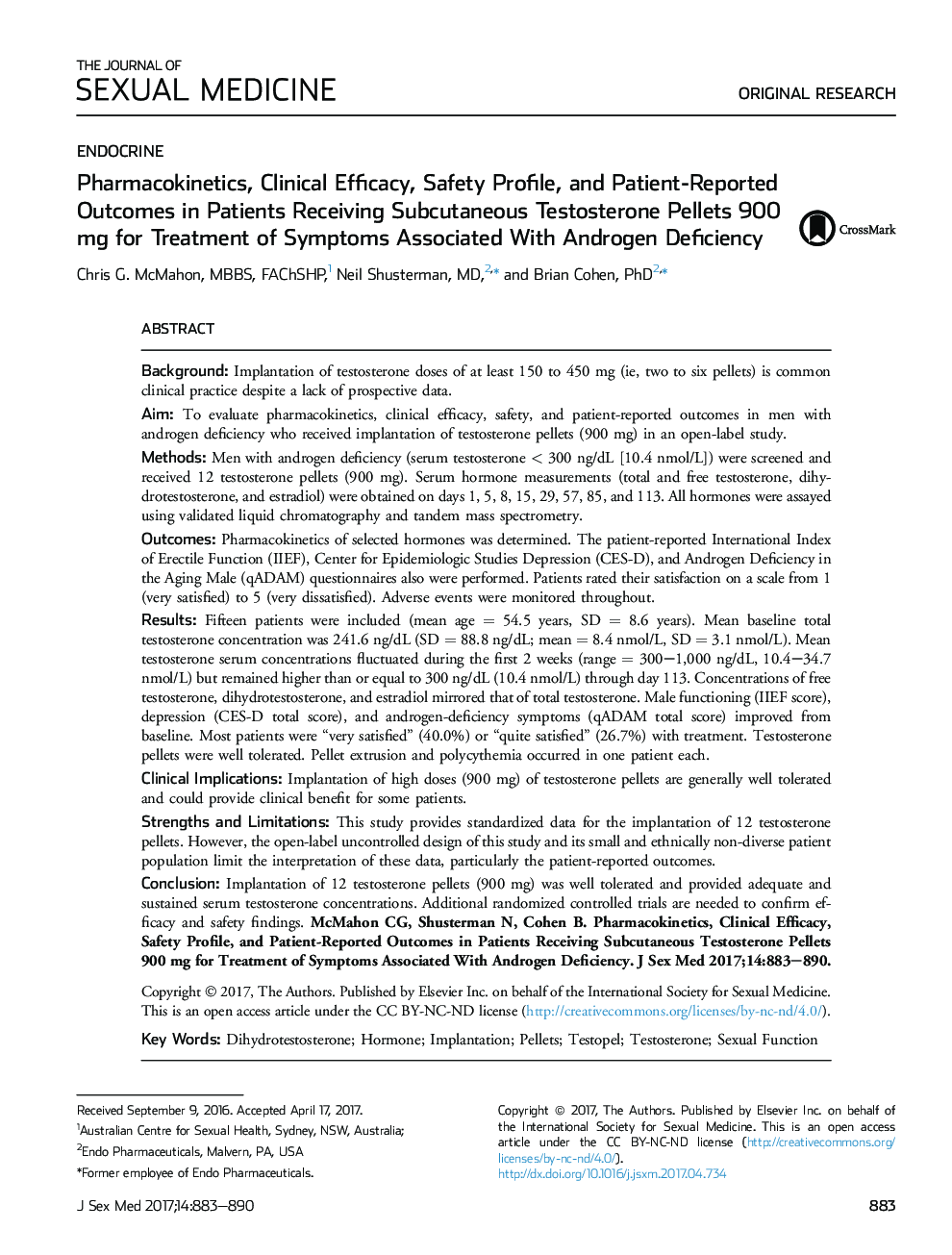| کد مقاله | کد نشریه | سال انتشار | مقاله انگلیسی | نسخه تمام متن |
|---|---|---|---|---|
| 5729831 | 1610813 | 2017 | 8 صفحه PDF | دانلود رایگان |

BackgroundImplantation of testosterone doses of at least 150 to 450 mg (ie, two to six pellets) is common clinical practice despite a lack of prospective data.AimTo evaluate pharmacokinetics, clinical efficacy, safety, and patient-reported outcomes in men with androgen deficiency who received implantation of testosterone pellets (900 mg) in an open-label study.MethodsMen with androgen deficiency (serum testosterone < 300 ng/dL [10.4 nmol/L]) were screened and received 12 testosterone pellets (900 mg). Serum hormone measurements (total and free testosterone, dihydrotestosterone, and estradiol) were obtained on days 1, 5, 8, 15, 29, 57, 85, and 113. All hormones were assayed using validated liquid chromatography and tandem mass spectrometry.OutcomesPharmacokinetics of selected hormones was determined. The patient-reported International Index of Erectile Function (IIEF), Center for Epidemiologic Studies Depression (CES-D), and Androgen Deficiency in the Aging Male (qADAM) questionnaires also were performed. Patients rated their satisfaction on a scale from 1 (very satisfied) to 5 (very dissatisfied). Adverse events were monitored throughout.ResultsFifteen patients were included (mean age = 54.5 years, SD = 8.6 years). Mean baseline total testosterone concentration was 241.6 ng/dL (SD = 88.8 ng/dL; mean = 8.4 nmol/L, SD = 3.1 nmol/L). Mean testosterone serum concentrations fluctuated during the first 2 weeks (range = 300-1,000 ng/dL, 10.4-34.7 nmol/L) but remained higher than or equal to 300 ng/dL (10.4 nmol/L) through day 113. Concentrations of free testosterone, dihydrotestosterone, and estradiol mirrored that of total testosterone. Male functioning (IIEF score), depression (CES-D total score), and androgen-deficiency symptoms (qADAM total score) improved from baseline. Most patients were “very satisfied” (40.0%) or “quite satisfied” (26.7%) with treatment. Testosterone pellets were well tolerated. Pellet extrusion and polycythemia occurred in one patient each.Clinical ImplicationsImplantation of high doses (900 mg) of testosterone pellets are generally well tolerated and could provide clinical benefit for some patients.Strengths and LimitationsThis study provides standardized data for the implantation of 12 testosterone pellets. However, the open-label uncontrolled design of this study and its small and ethnically non-diverse patient population limit the interpretation of these data, particularly the patient-reported outcomes.ConclusionImplantation of 12 testosterone pellets (900 mg) was well tolerated and provided adequate and sustained serum testosterone concentrations. Additional randomized controlled trials are needed to confirm efficacy and safety findings.McMahon CG, Shusterman N, Cohen B. Pharmacokinetics, Clinical Efficacy, Safety Profile, and Patient-Reported Outcomes in Patients Receiving Subcutaneous Testosterone Pellets 900 mg for Treatment of Symptoms Associated With Androgen Deficiency. J Sex Med 2017;14:883-890.
Journal: The Journal of Sexual Medicine - Volume 14, Issue 7, July 2017, Pages 883-890